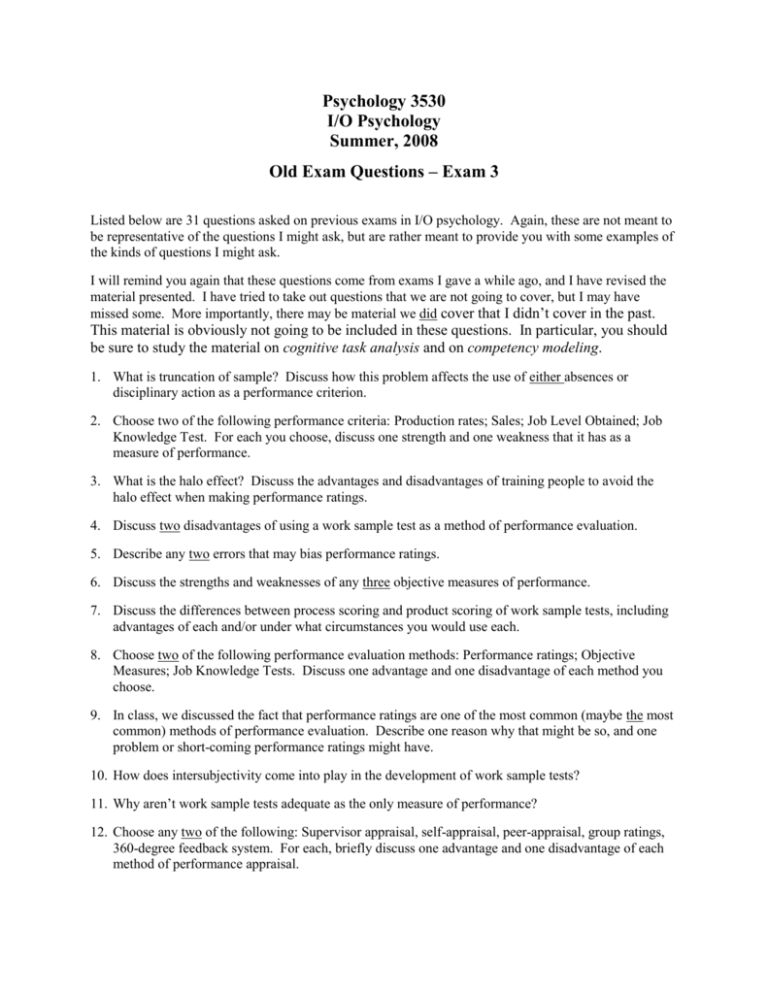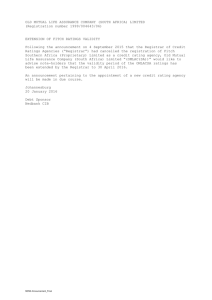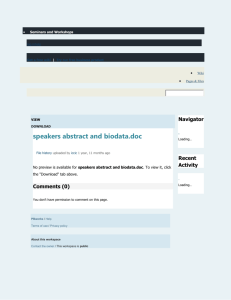old_qs.ex3
advertisement

Psychology 3530 I/O Psychology Summer, 2008 Old Exam Questions – Exam 3 Listed below are 31 questions asked on previous exams in I/O psychology. Again, these are not meant to be representative of the questions I might ask, but are rather meant to provide you with some examples of the kinds of questions I might ask. I will remind you again that these questions come from exams I gave a while ago, and I have revised the material presented. I have tried to take out questions that we are not going to cover, but I may have missed some. More importantly, there may be material we did cover that I didn’t cover in the past. This material is obviously not going to be included in these questions. In particular, you should be sure to study the material on cognitive task analysis and on competency modeling. 1. What is truncation of sample? Discuss how this problem affects the use of either absences or disciplinary action as a performance criterion. 2. Choose two of the following performance criteria: Production rates; Sales; Job Level Obtained; Job Knowledge Test. For each you choose, discuss one strength and one weakness that it has as a measure of performance. 3. What is the halo effect? Discuss the advantages and disadvantages of training people to avoid the halo effect when making performance ratings. 4. Discuss two disadvantages of using a work sample test as a method of performance evaluation. 5. Describe any two errors that may bias performance ratings. 6. Discuss the strengths and weaknesses of any three objective measures of performance. 7. Discuss the differences between process scoring and product scoring of work sample tests, including advantages of each and/or under what circumstances you would use each. 8. Choose two of the following performance evaluation methods: Performance ratings; Objective Measures; Job Knowledge Tests. Discuss one advantage and one disadvantage of each method you choose. 9. In class, we discussed the fact that performance ratings are one of the most common (maybe the most common) methods of performance evaluation. Describe one reason why that might be so, and one problem or short-coming performance ratings might have. 10. How does intersubjectivity come into play in the development of work sample tests? 11. Why aren’t work sample tests adequate as the only measure of performance? 12. Choose any two of the following: Supervisor appraisal, self-appraisal, peer-appraisal, group ratings, 360-degree feedback system. For each, briefly discuss one advantage and one disadvantage of each method of performance appraisal. 13. Evaluate the use of sales as a performance appraisal measure. Be sure to use dimensions for your evaluation that were discussed in class and/or your textbook. Be sure to explain/backup your evaluation. 14. Describe one form of error discussed either in class or the book as a problem in performance ratings. How might rater error training help reduce the problem? What might be negative about rater error training? 15. Some performance measures have a problem with truncation of sample. What is this, and why is it a problem? Why is likely to be a problem with absences as a performance evaluation measure, but not such a problem with sales as a performance evaluation measure. 16. In class, we discussed the fact that work sample tests and work knowledge tests are not adequate as the only measure of performance appraisal. Why not? (Be sure to describe what these two methods of performance appraisal are). 17. Choose one hiring predictor that was discussed either in class or in your textbook. Evaluate this predictor using the following four criteria: Cost, Fairness, Validity & Applicability. Be sure to discuss how or why the evaluation is the way it is. 18. Choose one of the following personnel selection techniques: BioData, Situational Exercises, Work Samples. How good is this as a personnel selection technique? (Hint: Use all relevant criteria for the evaluation of a personnel selection technique). 19. Discuss whether or not interviews are good personnel selection techniques. Be sure to explain what qualities make them good or bad. Discuss at least one factor that leads to interviews having those qualities. 20. BioData is often used as a job selection technique. Focusing only on its ability to pick the best employees, discuss whether or not the questions asked should be relevant to the job. (Be sure to explain why it should or shouldn’t be relevant). 21. Contrast the construct or constructs being measure by tests of general intelligence (such as the WAIS) and Aptitude Batteries (such as the GATB). 22. Discuss the criterion validity of the General Aptitude Test Battery – especially as it compares to validity of general intelligence tests. 23. Discuss whether aptitude batteries such as the Generalized Aptitude Test Battery can add to the quality of a hiring technique. 24. Compare & Contrast: Overt Integrity Tests & Personality Integrity Tests. 25. Define differential validity. How does it relate to fairness? How does it relate to criterion validity? 26. In class, we discussed the fact that interviews, as they have traditionally been done, are not particularly valid means of choosing employees. Briefly discuss why this might so, and describe two strategies that can improve the validity of interviews. For each of the two strategies, be sure to make it clear how that helps 27. According to your textbook, “the biggest criticism of biographical inventories” (biodata) “is that items on the empirical inventory are chosen based entirely on their ability to predict performance and not on an apparent link to job requirements.” What does this mean? How might someone defend the use of biodata against this criticism? 28. Compare and contrast: The use of intelligence tests (cognitive ability) and the use of tests of specific abilities (multiple aptitude batteries) as hiring predictors. In general, which do you think are better to use as predictors? Why? 29. Suppose I find that asking people how often they go to church is a good predictor of how reliable a worker they will be. Should I use this as one of the hiring predictors? Why or why not? 30. Compare and contrast: The rational approach to biodata and the empirical approach to biodata. Discuss the strengths and weaknesses of each approach. 31. Interest testing can be used in one of two ways: activity-similarity or people-similarity. Compare these two types of usages. 32. As an industrial psychologist, you are called in to consult with a company about a new performance appraisal system for their sales representatives. The CEO of the company questions your hiring by saying: “Why do we need to pay some PhD all that money? Just look at the amount they sell! A sales rep who sells a lot has good performance!” How do you answer this comment? (Provide as much detail as possible). 33. Work sample tests are probably more valid measures of performance than job knowledge tests. Why? 34. Behaviorally anchored rating scales are probably better measures of performance than are rating scales that aren’t behaviorally anchored. Why? 35. Discuss the strengths and weaknesses of biodata (biographical inventories) as personnel selection methods. Be sure to cover validity, cost, applicability, and fairness, among other things. 36. What is the ‘big 5’? Discuss how the big 5 could be used for hiring. Be sure to discuss how different elements of the big 5 may have validity for different kinds of jobs. 37. Discuss two things that can improve the validity of interviews as hiring predictors. One of the things you discuss should improve validity by trying to reduce the effect of the bias of the interviewers, and one of the things you discuss should improve validity by trying to reduce the problem of an interview being different for different applicants. Be sure to clearly identify (a) what each of these two problems are, (b) what each of the methods of improving interviews are, and (c) how the method of improving the interview attacks the problems. 38. Compare and contrast: Work Sample Tests and Psychomoter Ability Tests. 39. Assessment centers are supposed to measure a variety of different dimensions (such as leadership, initiative, communication skills). Discuss how the correlations among the different dimensions can be interpreted as a weakness of assessment centers.







